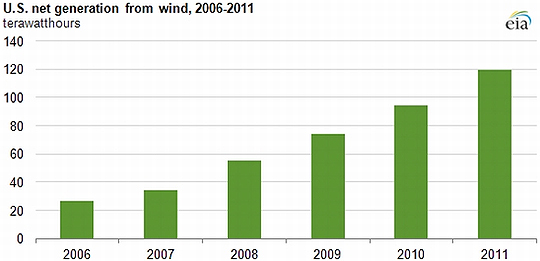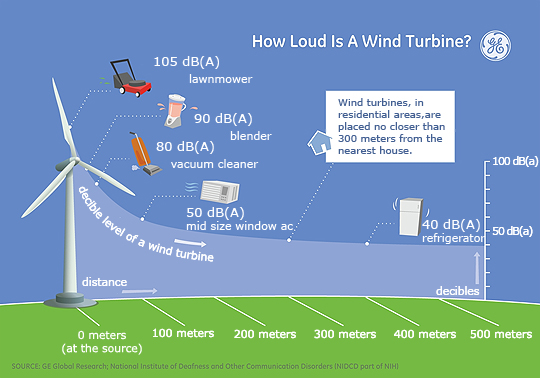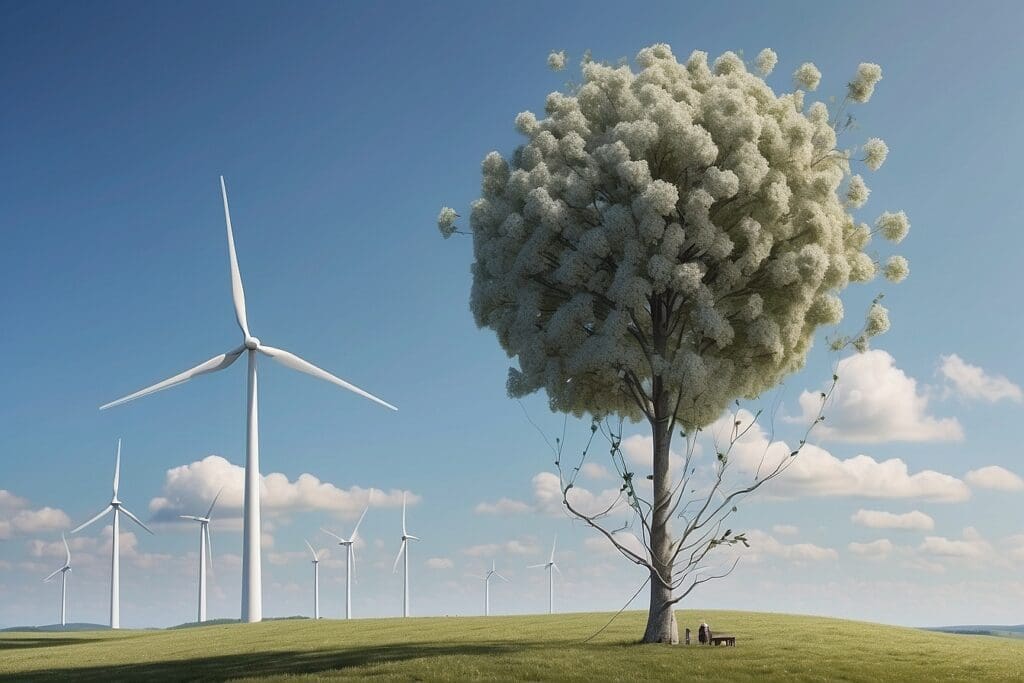Most people have heard the complaints about wind turbines, which are used to create renewable and clean wind energy. These common complaints are that the turbines obstruct pleasant views and disrupt bird flight paths. But now a new complaint is starting to become more widespread. Wind Turbine Syndrome, as it is known, is purportedly caused by the low-frequency infrasound that turbines make, and is characterized by sleep disturbances, headaches, and concentration problems.1 In addition to these common complaints 155 different disorders have been associated with the syndrome, including “several types of cancer, and both losing weight and gaining weight.”2 Unlike most health issues, Wind Turbine Syndrome has many doctors and scientists scratching their heads. Scientists have not been able to actually find a causal link between the installation of turbines and the syndrome. So what is going on here?
Wind Turbine Rise

In 2012, wind power accounted for almost three and a half percent of total electricity power in the United States.3 Although 3.5% may seem small, in 2012, wind energy became “the fastest-growing source of new electricity generation in the U.S.” In fact, 42% of new energy generation capacity in the year 2012 was from wind.4 The U.S. Department of Energy’s (DOE) 2008 report titled 20% Wind Energy by 2030 envisioned that under a scenario in which “wind energy would supply 20% of all U.S. electricity, offshore wind could provide 54 GW of generating capacity and 4% of the nation’s total electricity” by 2030.5 Indeed, the Interior Department has announced that it is finalizing the first federal offshore wind lease sale in U.S. history to keep this momentum going. It is set to auction almost 165,000 acres of land on July 31, 2013 for wind energy development off the shores of Rhode Island and Massachusetts.6
 7
7
Wind Turbines and Infrasound
With such a large increase in the number of wind farms, turbine neighbors started to become more concerned about the injurious effects that might result, particularly from the noise and vibrations of the turbines. The tips of wind turbine blades spin faster than you might realize. In high winds they can reach up to 180 miles per hour. Such rapid spinning can create what is known as infrasound—low frequency sounds that cannot be heard by the human ear, but that can carry for hundreds of miles across a landscape.8 Although infrasound is all around us in today’s world—it leaks from offices, road traffic, refrigerators, and so on9—anti-wind advocates are particularly concerned that the high levels of infrasound created by turbines could disturb the “delicate vestibular system of the inner ear.”10
 11
11
In an effort to cut down on this noise, engineers are designing new technologies with sound-dampening systems and quieter blade design.12 The question is whether these new technologies, combined with minimum distance requirements ensuring that turbines are not built too close to homes or workplaces,13 are enough to protect residents.
Potential Health Issues
People living near wind farms across the globe are increasingly reporting headaches, insomnia, ringing in the ears, and other symptoms. For example, a number of residents in one Massachusetts community report sleep interruptions and headaches that they say are associated with a Syndrome that is “like sea sickness — some people feel it, others don’t.”14 This idea that Wind Turbine Syndrome is like sea-sickness makes sense. However, recent studies indicate that those who experience Wind Turbine Syndrome are not sick because they are extra sensitive to low frequency noise, but rather because they are psychologically predisposed to react badly to negative information on wind turbines.
The three different case studies that follow help to explain Wind-Turbine Syndrome:
- A study about Wind Turbine Syndrome in Australia published by University of Sydney Professor of Public Health, Simon Chapman, explains that only five of the 49 wind farms in Australia have ever prompted complaints. What’s more, all five farms had been targets of anti-wind activism. Chapman also found that while wind turbines have been used in Australia since 1993, over 80% of Wind-Turbine Syndrome complaints arose after 2009, when anti-wind groups first began emphasizing the potential health hazards of wind turbines.15 Chapman and others have argued that Wind Turbine Syndrome is thus a result of the nocebo effect—an effect where the mere suggestion that something could be harmful to your health causes it to be harmful.16 In this case, when people living in the vicinity of wind farms are regularly exposed to negative health information claiming that wind turbines are harmful, they become more likely to report symptoms.
- In a study published by the American Psychological Association’s Health Psychology journal, researchers from New Zealand’s University of Auckland performed an experiment where they showed different health information to different groups. In the study, 27 people were shown anti-wind power film footage, while another 27 were shown interviews with experts who said that wind turbine infrasound cannot directly cause negative health effects. The subjects were then told they would be exposed to periods of infrasound. After both real and “sham” or placebo exposure, people in the group shown anti-wind power film footage were much more likely to report negative symptoms than those in the group that were not shown this negative information. This study suggests that the health complaints associated with Wind-Turbine Syndrome could be linked to psychological expectations. In other words, “symptom expectations are the root cause of symptom reporting.”17
- An independent panel convened in 2012 by the Massachusetts Department of Environmental Protection reviewed all available research on Wind Turbine Syndrome. They found that there is no scientific evidence to support most claims about “Wind Turbine Syndrome,” such as vestibular system disruptions, pain and stiffness, diabetes, high blood pressure, tinnitus, hearing impairment, psychological distress, mental health problems, cardiovascular disease, and headache/migraine. At worst, there is limited evidence that wind installations may cause annoyance and sleep disruption. However, there is “insufficient epidemiologic evidence” to determine whether there is “an association between noise from wind turbines and annoyance independent from the effects of seeing a wind turbine and vice versa.”18
What to Make of Wind Turbine Syndrome
The debate about Wind Turbine Syndrome pulls me in two different directions. On the one hand, it is sad and infuriating that anti-wind farm groups can bolster their campaigns by focusing on unproven health concerns, and thereby elicit complaints and negative sentiment from communities. This is particularly tragic given the documented negative economic and health effects of using fossil fuels for energy.19
On the other hand, it is concerning to think about how supporters of hydraulic fracturing and traditional fossil fuel extraction might use these Wind Turbine Syndrome results to call into question the symptoms reported by those who are in close proximity to drilling, pipelines, or power plant operations. Imagine if someone came out with a report showing that people living near fracking sites were more likely to report symptoms associated with drinking contaminated water after they watched the movie Gasland.20 Matters of public health and safety should not be taken lightly—it is important to continue to study possible effects of all types of energy production on health. The only way to equitably distribute the hazards and benefits of our various energy production options will be to listen to public concerns, investigate them as much as possible, weigh them against other options, and be wary of false arguments.





